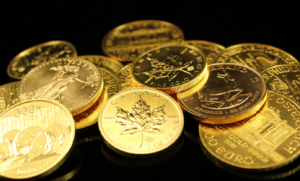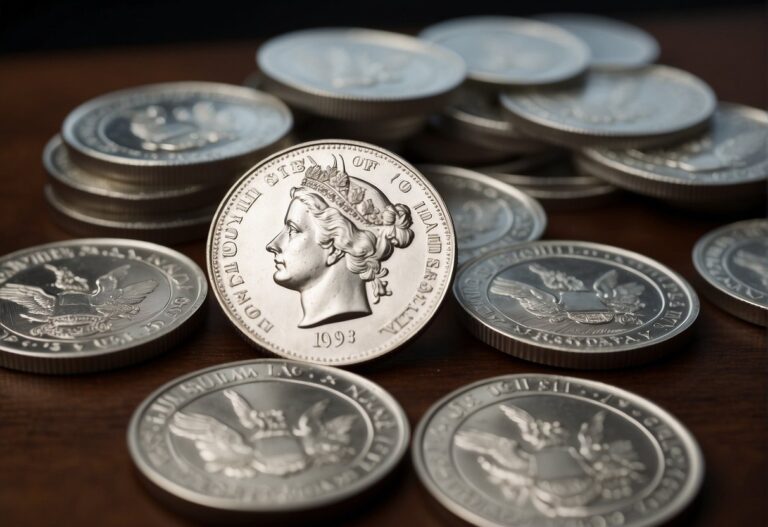IRA Approved Silver has become a popular investment choice for individuals looking to diversify their retirement portfolios.
Certain types of silver are designated as “IRA-approved” within the realm of individual retirement accounts (IRAs). This categorization implies that the silver meets specific eligibility criteria set forth by the IRS for inclusion in a Self-Directed IRA.
To be considered IRA-approved, silver must be at least 99.9% pure and produced by a government mint or an accredited manufacturer.
This high standard of purity ensures that the silver is of sufficient quality for retirement savings.
Investing in IRA-approved silver allows investors to hold a tangible asset with a history of withstanding economic fluctuations.
In addition to its purity, additional requirements must be fulfilled concerning storage, custodianship, and compliance with IRS regulations.
Selecting the proper custodian and secure storage facility is critical, as is understanding the potential tax implications of silver IRAs.
IRA Approved Silver Key Takeaways
- IRA-approved silver must meet purity and production standards.
- Investments must follow regulatory compliance, custodianship, and secure storage guidelines.
- Silver can offer a tangible asset option within a diversified retirement portfolio.
Understanding IRA Approved Silver
Investing in precious metals like silver can be an effective way to diversify a retirement portfolio.
IRA-approved silver refers to specific silver products that meet the eligibility criteria for inclusion in an Individual Retirement Account (IRA).
The Internal Revenue Service (IRS) sets these standards, emphasizing fineness and minting requirements for the silver to qualify.
The primary specification for IRA-approved silver is its minimum fineness level. Silver products must be at least 99.9% pure.
This high standard of purity ensures the metal’s quality and uniformity, making it a trusted investment vehicle for IRAs. Below is an outline of eligible silver products:
- Silver Coins: Must be minted by government entities and adhere to the purity standards.
- Silver Bars: These can come from either government mints or accredited private manufacturers but must also meet the 99.9% purity requirement.
| Type | Purity | Accreditation |
|---|---|---|
| Silver Coins | 99.9% or higher | Government Mint |
| Silver Bars | 99.9% or higher | Gov’t/Private Mint |
Investors must confirm that any silver purchase for an IRA is sourced from a national government mint or an accredited manufacturer recognized by the market.
These rigorous standards help protect investors by ensuring the silver’s authenticity, purity, and, ultimately, its marketability when it comes time to liquidate the investment.
When considering this type of investment, individuals should consult financial advisors to fully understand the implications of adding precious metals like IRA-approved silver to their retirement saving strategies.
Benefits of Including Silver in Your IRA

Silver in an individual retirement account (IRA) can offer numerous financial advantages.
Silver, a tangible asset, provides a sense of security as it is a physical commodity with intrinsic value.
Silver offers a way to diversify retirement savings, critical in managing risk when held within an IRA.
Diversification: A core component of a robust investment strategy, diversification helps spread risk. Silver can balance a portfolio because its price movement often differs from stocks and bonds.
Hedge Against Inflation: Over time, silver has maintained purchasing power. It stands as a hedge against inflation, potentially protecting the value of retirement savings as the cost of living increases.
Tangible Asset: Unlike digital assets or paper currency, silver is a tangible asset that investors can hold, fostering a sense of control and stability over one’s investments.
Retirement Savings: Investing in silver through an IRA can aid in steadily growing retirement savings.
Silver can be another vehicle for retirement planning, given that it is approved for inclusion in IRAs, following IRS guidelines.
Types of Silver Eligible for IRAs
Only specific types of silver are eligible for an Individual Retirement Account (IRA) for silver investments. These include certain coins and bullion that meet the IRS’s rigorous purity and authenticity standards.
Silver Coins
Eligible silver coins for IRAs are those issued by government mints with a fineness of .999 or more.
- American Silver Eagle: The standard bullion version of this coin is eligible for IRAs, as it meets the purity requirements.
- Canadian Silver Maple Leaf: Recognized for its .9999 fineness, this coin is also IRA-approved.
- Mexican Silver Libertad: These coins are IRA-eligible due to their .999 fineness and government-backed quality assurance.
Proof coins, such as American Eagle Proof Coins, are collectible and often included in IRAs. However, their eligibility might vary, so investors need to confirm the coins meet IRA requirements.
Silver Bullion
Silver bullion products qualify for an IRA if they meet the minimum fineness requirement of .999.
- Bars and Rounds: These products come from private mints and should display .999 purity to be considered IRA-eligible.
Eligible silver must also be produced by a certified manufacturer, assayer, or refiner accredited by NYMEX, COMEX, or other recognized organizations.
Requirements for Silver IRA Investments
Investors seeking to diversify their retirement portfolios can opt for a precious metals Individual Retirement Account (IRA), specifically a silver IRA account, which includes physical silver as part of its assets. To comply with Internal Revenue Service (IRS) regulations, they must ensure that their investment meets specific requirements.
Firstly, silver must be at least 99.9% pure. This standard is critical for all silver included in a self-directed IRA. The purity level ensures that the silver holds investment-grade quality, which is necessary for IRA approval.
Secondly, the silver should be produced by a national government mint or an accredited private manufacturer.
This is to guarantee the silver’s authenticity and fineness. Some well-recognized options among IRA-approved silver products include American Silver Eagles and silver bars or rounds that fulfill the purity criteria.
An IRA custodian, a financial institution approved to hold IRA assets on behalf of the investor, must handle the transactions and storage of physical precious metals.
The investor cannot directly manage the physical silver; this role is designated to the custodian to ensure adherence to IRA regulations.
Here is a quick rundown of the critical criteria for silver investments in an IRA:
- Purity: Minimum .999 fineness.
- Mintage: Produced by accredited mints.
- Custodianship: Held by an authorized custodian.
These requirements ensure investors have a secure and compliant investment, fulfilling the need for a stable and tangible asset within their retirement portfolios.
Choosing a Custodian for Silver IRA Approved Silver
When an investor decides to include silver in their Retirement Account (IRA), it is crucial to select a trustworthy IRA custodian.
These custodians, typically financial institutions or specialized firms, have the authority to hold and secure the physical precious metals for the account owner.
Critical Functions of IRA Custodians include:
- Ensuring that the silver investments comply with IRS standards.
- Handling all administrative duties associated with the silver assets within the IRA.
- Facilitating transactions on behalf of the investor, including buying and selling silver.
Factors to Consider When Selecting a Custodian:
- Credentials and Experience: An investor should seek a custodian with robust credentials and a proven track record in managing precious metals within IRAs.
- Fees: Costs can vary, so it’s essential to compare the fee structures of potential custodians.
- Services: The custodian should offer a full suite of services, including transparent reporting and easy accessibility to account information.
Custodian and Precious Metals Dealer Relationship
While some custodians may offer the option to purchase silver directly, others require the investor to work with a precious metals dealer.
Ensuring that any dealer chosen is reputable and that the silver purchased meets the IRA eligibility criteria is critical.
A synergistic relationship between custodian and dealer can streamline the process and offer investors peace of mind.
Storage Options for IRA Approved Silver
When investors add silver to their Retirement Accounts (IRAs), they must adhere to IRS regulations regarding storage.
Silver and other precious metals cannot be stored at home or in a safe. They must be held in a secure environment, specifically an IRS-approved depository.
Depositories resembling banks in security features are designed to store precious metals.
The IRS has strict guidelines to ensure the safety of IRA assets, which dictate that only approved facilities may be used to house IRA silver.
Investors have the option to choose between two types of depositories:
- Segregated Storage: Precious metals are stored separately from the assets of other investors. This ensures that the investor retains direct ownership of the metals they deposited.
- Commingled Storage: Assets from various investors are stored together. Individual segregation is not maintained, but the investor still owns a specific, allotted amount of silver.
It is crucial for clear documentation to be kept to illustrate ownership and the presence of the silver in the depository.
Depositories must also carry comprehensive insurance policies to protect the investor’s assets.
Tax Implications of Silver IRA Accounts

When individuals invest in physical silver through their retirement accounts (IRAs), they should be aware of the tax implications of both Traditional and Roth IRAs.
Traditional IRAs:
- Contributions may be tax-deductible depending on the investor’s income level and participation in employer-sponsored retirement plans.
- Taxes are deferred until withdrawals begin, typically at retirement age.
- Withdrawals are taxed as ordinary income at the investor’s current tax rate at withdrawal time.
Roth IRAs:
- They offer no upfront tax deductions for contributions; however, qualifying withdrawals during retirement are tax-free.
- Growth of investments within a Roth IRA is not subject to tax as long as the account has been open for at least five years and withdrawals are made after 59½.
Both account types adhere to the Internal Revenue Service (IRS) stipulations that the silver must be pure, typically fined .999, and produced by a reputable mint or manufacturer.
| Account Type | Contribution Tax Benefit | Withdrawal Taxation |
|---|---|---|
| Traditional | Tax-deductible | Taxed as income |
| Roth | None (tax-free growth) | Tax-free |
Investors should consult a tax professional to understand the nuances of silver investments in IRAs and ensure compliance with all relevant tax laws.
This is particularly important for self-employed individuals who utilize a SEP IRA with contribution limits and tax advantages.
Engaging with a tax professional can help optimize retirement accounts for tax efficiency.
Comparing Silver IRA Accounts to Other Retirement Account Options
When considering different retirement options, investors often weigh the distinct features of assets such as stocks, bonds, real estate, and other precious metals against Silver IRAs.
Diversification, market volatility, and tax implications are crucial in understanding how Silver IRAs fit within an individual’s retirement strategy.
Stocks and Bonds
Stocks are equity investments that offer partial ownership in a corporation, while bonds are debt securities where the investor loans money to an entity.
These traditional components of a retirement account usually fluctuate with market conditions, presenting a varying degree of market volatility.
In comparison, a Precious Metals IRA that holds silver products is often viewed as a hedge against inflation and market downturns because silver may retain its value or even appreciate when other assets decline.
Real Estate
Real Estate investment is a tangible asset option for retirement planning, often included in a self-directed IRA.
Unlike silver, real estate has the potential for rental income, but it also requires active management and can be subject to market and regulatory risks.
Real estate’s performance is uncorrelated with financial markets. It offers diversification but also involves liquidity issues compared to silver products, which are easier to buy and sell.
Gold, Platinum, and Palladium
Alongside silver, other precious metals like gold, platinum, and palladium are eligible for inclusion in a Precious Metals IRA.
Each metal has unique attributes; gold is traditionally sought after for its enduring value, while platinum and palladium are rarer and heavily used in industrial applications.
They may offer diversification benefits, but silver is often famous for its affordability and potential growth in industrial demand.
When contrasted with an employer retirement plan that might be limited to stocks and bonds, a Precious Metals IRA permits the inclusion of these metals, providing an alternative avenue for wealth preservation.
How to Invest in a IRA-Approved Silver Account
Investing in silver can be a strategic way to diversify one’s retirement portfolio. To invest in IRA-approved silver, one should ensure compliance with IRS regulations.
Silver must be 99.9% pure and produced by a national government mint or an accredited manufacturer.
One begins by setting up a Self-Directed Individual Retirement Account (IRA) through a certified custodian. This custodian will manage the transactions and storage of the physical silver on behalf of the investor.
Eligible Silver IRA Products:
- American Silver Eagles: A popular choice for IRA investments, these coins are recognized for their purity and are backed by the US government.
- Canadian Silver Maple Leaf Coins: These coins are also eligible for IRA investment. They are known for their 99.99% purity and are backed by the Canadian government.
Steps to Invest in IRA-Approved Silver:
- Choose a Custodian: Select a reputable IRA custodian experienced in precious metals.
- Open an IRA Account: Complete the required documentation for a Self-Directed IRA.
- Funding Your IRA: Roll over funds from an existing IRA or make a new contribution to your account.
- Select Silver Products: Purchase IRA-approved silver products like American Silver Eagles or Canadian Maple Leaf coins through your custodian.
- Storage: The custodian will arrange for the secure storage of the physical silver, often in an insured depository.
Investor’s Checklist:
- Confirm the purity of the silver (minimum 99.9%).
- Ensure the product is from a government mint or an accredited manufacturer.
- Work with a trusted custodian who specializes in precious metals IRAs.
Investors must be aware of the market trends and conduct due diligence when choosing IRA-eligible silver products to ensure a prudent addition to their retirement savings.
Silver IRA Account Regulations and Compliance
When an investor considers adding silver to an Individual Retirement Account (IRA), understanding the Internal Revenue Service (IRS) regulations is crucial. The IRS sets forth specific guidelines that silver assets must meet to qualify for an IRA.
Purity Standards:
- Silver coins and bars must be at least 99.9% pure.
IRA Approved Silver Coins:
- The IRS has sanctioned various government-minted silver coins for IRA inclusion.
- Examples include the American Silver Eagle and the Canadian Silver Maple Leaf.
Approved Silver Bars:
- Silver bars also qualify if they meet the necessary fineness standard.
- Manufacturers must produce them that the COMEX, NYMEX, or a national government mint accredit.
Non-Approved Metals:
- Collectible coins and certain foreign coins do not meet the purity requirements set by the IRS.
- Even if silver, these assets are considered non-compliant for an IRA.
Compliance for Custodians:
- Custodians overseeing a silver IRA must ensure the purchased silver complies with IRS standards.
- They are also responsible for storing the silver in a secure, IRS-approved depository.
Investors who have opted for a Silver Individual Retirement Account (IRA) should regularly monitor their investments to ensure they align with their retirement goals.
Since the price of silver can be volatile, staying informed about market trends is crucial for managing the investment effectively.
Portfolio Assessment
An investor should periodically review the silver holdings within their investment portfolio.
This can be done through quarterly reports issued by the IRA custodian, which detail the current value of the silver assets based on the prevailing market price.
Balance Adjustments
Investors may need to adjust their silver holdings to mitigate silver volatility risks.
This involves reallocating assets within their portfolio to maintain the desired level of risk and potential growth.
Custodian Communication
A fundamental entity in managing a Silver IRA is the IRS-approved custodian.
Investors should maintain regular communication with their custodian, who is responsible for safekeeping the precious metals and executing transactions on the investor’s behalf.
Market Insight
Staying updated on industry news and the factors influencing the price of silver allows investors to make informed decisions.
By understanding the market, they can time the buying or selling of silver to optimize their returns.
Diligence and Compliance
Finally, investors should ensure their Silver IRA continues to meet IRS requirements.
They must only hold IRS-approved silver products and work with a custodian to comply with all regulatory obligations.
Silver IRA Account Frequently Asked Questions
In this section, readers will find answers to common queries concerning IRA-approved silver, detailing types of eligible coins, rules, fees, rollover processes, benefits, and eligibility criteria for silver investments in an Individual Retirement Account (IRA).
What types of silver coins are eligible for an IRA?
The American Eagle bullion and the America the Beautiful series are IRA-eligible silver coins. A national government mint must produce these coins and meet purity and fineness requirements.
Can you explain the rules governing a precious metal IRA?
A precious metal IRA must hold bullion or coins that meet specific purity standards, at least 99.9% silver. These investments must be held in an approved depository and cannot be in the IRA owner’s physical possession.
What are the fees associated with a precious metals IRA?
Fees for a precious metals IRA can include setup fees, annual account fees, storage fees, and insurance fees. These vary by provider and should be reviewed carefully before opening an account.
How do I rollover my existing IRA into a precious metals IRA?
To roll over an existing IRA into a precious metals IRA, one must open a self-directed IRA with a custodian that allows precious metal investments. Then, transfer funds from the current IRA to the new one and use the funds to purchase IRA-approved silver.
What are the benefits of investing in a Silver IRA Account?
Investing in a silver IRA can diversify a retirement portfolio, offering a hedge against inflation and market volatility. Silver is a tangible asset that can hold intrinsic value over time.
How does one determine if a Silver Coin is IRA-eligible?
To determine if a silver piece is IRA-eligible, one must verify that the silver meets IRS standards for purity (.999 fineness) and is produced by an accredited manufacturer or government mint.




